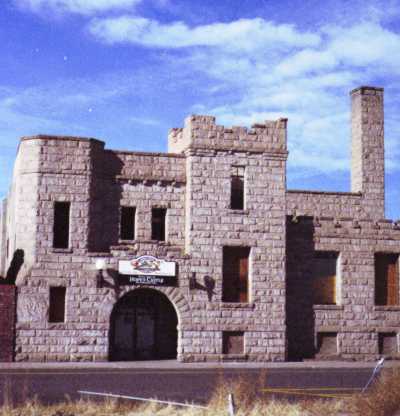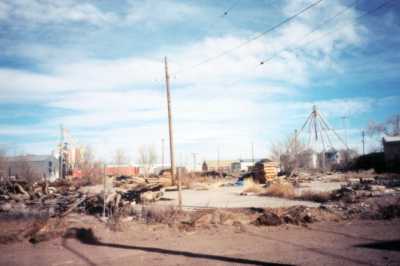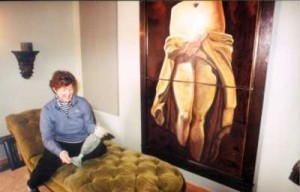Article by Marcia Darnell
Local History – February 2004 – Colorado Central Magazine
DURING WORLD WAR II, German prisoners of war lived and worked in the San Luis Valley. The stories of their lives here, and afterward, abound throughout the Valley. Although they were only here for a couple of years, their work lives on, and the impact of their time here still resonates.
In 1943, farm labor was scarce. The workers, mostly men, were at war and the crops were suffering. That summer, German prisoners of war were transferred from the POW camp in Trinidad to work on farms in the Monte Vista area.
According to Bridge to Yesterday, published by Emma M. Riggenbach in 1982, 250 prisoners were brought to the San Luis Valley by train. Many Valley residents turned out to the depot to see “the enemy” arrive. Accommodations had already been constructed for the workers by assessing participating farmers $1 per acre of potatoes. The $5,000 raised paid for a barracks and mess hall.
The farmers were also issued a list of rules for treatment of the prisoners under the Geneva Convention.

Fraternization was strictly forbidden, as were outgoing phone calls, cables and telegrams. Mail was censored, both incoming and outgoing, and the workers’ clothing had to come from the War Department and identify them as prisoners.
The work detail was voluntary; any POW who wanted to quit could go back to Trinidad.
“I remember them singing as they marched two by two,” said Peggy Barr. The director of the Monte Vista Historical Society was a girl when the POWs worked in her town. “I remember seeing them watching the girls go by.”
Bette Deacon was a young married woman when two of the POWs came to work on her parents’ farm.
“I worked with them on the farm,” she said.
Deacon’s parents, Doyle and Phylene David, raised cattle, sheep, pigs, alfalfa, Red McClure potatoes, and feed grain near Monte Vista.
“I graduated in 1939 from the Sargent Consolidated School and the war started in 1941,” she said. “My son, Gary, was born one month before Pearl Harbor.” Her husband, Shirley Gordon Deacon, was classified 4-F, and worked on the farm with her parents.
“My dad used to go in after them, pick them up,” Deacon remembered, “and they would sit out in the yard in a swing at noon, having lunch, and my mother would bake cakes or something. They were just kids, young kids.
“We couldn’t talk German, and they couldn’t talk English,” she said. “Fritz would correspond by sign language with my husband when they worked on the farm.”
The two prisoners who worked for them were George Fischer and Fritz Vilmer.
“Those boys, I think, were picked up fighting with Rommel,” Deacon said.
AT FIRST, the prisoners working in the Valley were accompanied by armed guards, but by the spring of 1944, the workers went out alone to the farms and fields.
Deacon remembers a time when her father, spotting a coyote after the sheep, made signs to Fritz to go and get his gun.
“So Fritz galloped back up to the corral and brought the gun down, and when he handed the gun to my dad, they had a big laugh,” she said.
“They were just nice kids.”
Nancy Schrader’s father also employed POWs. “My father had three or four workers that he went into town and got when we were haying,” she said. “I remember when they left they gave us some mittens that they had. They were really big, and Army-colored, and rabbit-fur lined. They had pockets: one for the little, ring and middle finger; one for the thumb; and then one for the trigger finger. They were so big I used one for a pad to sit on when I went skating.”

Schrader was very young during the war, so her memories are limited.
“I remember they had to eat outside, and I thought that wasn’t very gracious of my father,” she said. “They brought a sack lunch to work, and during their lunch time they taught our little dog tricks.”
Not all of the POWs worked in agriculture. Some worked at the cheese factory in Del Norte, some helped lay electric and telephone lines; and some worked as mechanics. Others worked in the prison barracks, kitchen and mess hall.
The prisoners were paid for their work; the employers paid $5 a day for each man, and the workers got 80 cents of that.
No escape attempts or “ungentlemanly conduct” were reported. Sources say that sometimes prisoners would walk away from the camp, usually to visit a local bar. They’d return afterward.
By the fall of 1945 the POWs in the San Luis Valley numbered 650.
AFTER THE WAR, things were tough in Germany. The prisoners returned home to find their land and families suffering. Many of the farmers they had worked for in the San Luis Valley stayed in touch with them, and helped as they could.
“George Fischer, he wrote to us, my husband and I,” Deacon said, “and I had to have someone translate. My parents sent packages of food to Fritz Vilmer and his family.
“Fritz Vilmer died in the 1970s,” Deacon said. “His wife said he spoke often of his time in the San Luis Valley.”
A Bridge to Yesterday reports that Lyman and Edith Wright maintained a correspondence with Leopold Kronlochner, who worked on their garden during the war. Ralph Scheel and family kept up with Reiner Jansen, who returned to visit them in 1980.
Barr said another former POW returned to Monte Vista for a visit many years later.
Many in the San Luis Valley fondly remember the German soldiers who worked with them, and evidence of their work remains, in healthy farms, power lines, and wonderful stories. Some good things can happen, even in the worst of times. The German men who came to the San Luis Valley as prisoners and returned, later, as free men with good memories of their time here are proof of that.
Marcia Darnell lives, works, and reads history in Alamosa.


